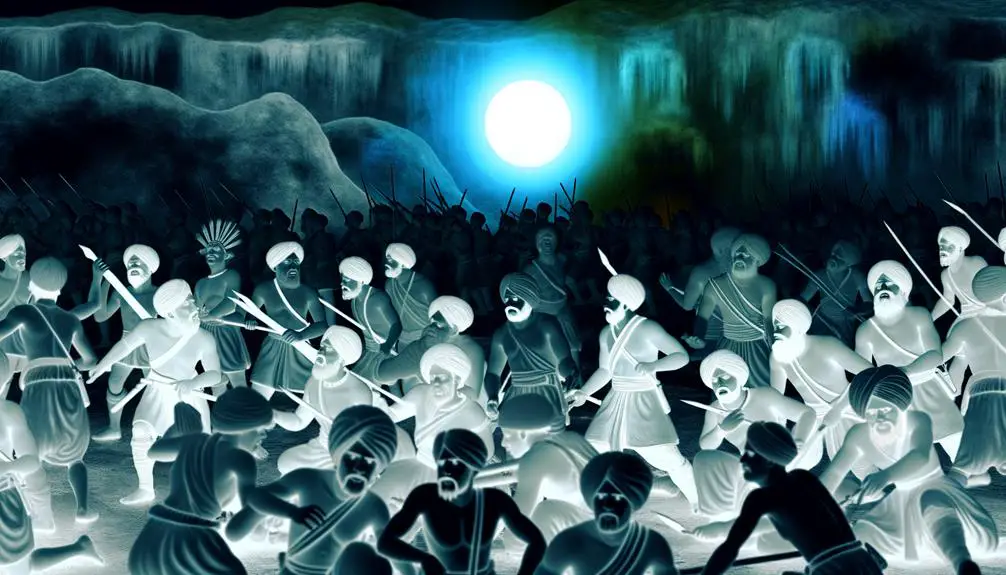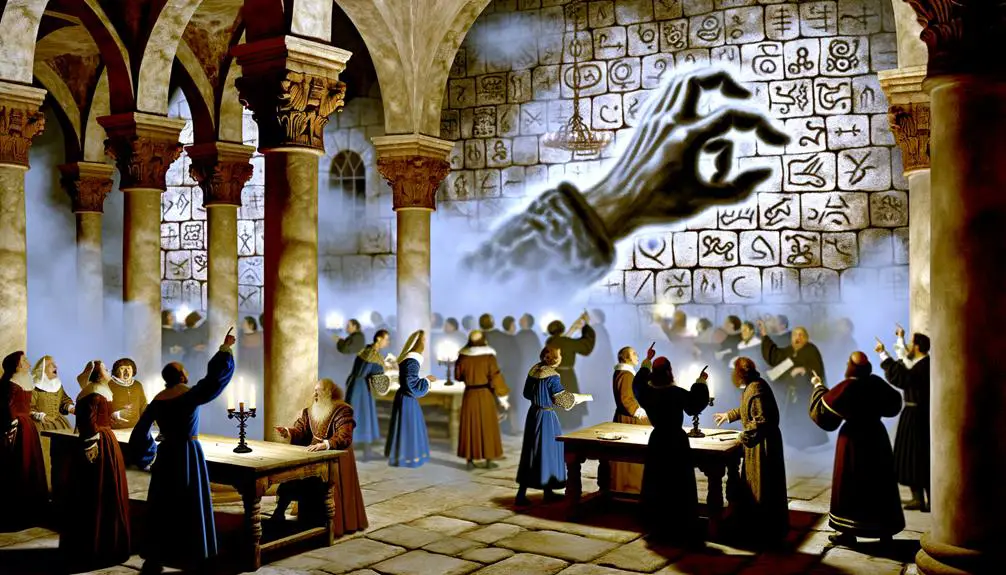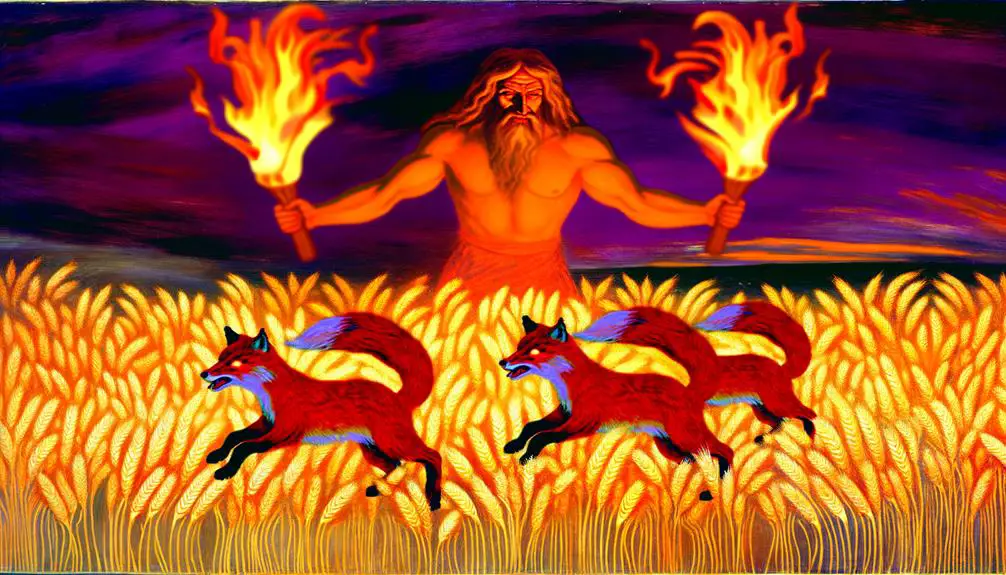Kooky and bizarre Bible tales await, inviting you on a journey to uncover their hidden messages and meanings—dare to delve deeper?

Weirdest Things in the Bible
The Bible, with its rich tapestry of history and spirituality, contains moments that might gently be described as out of the ordinary. You've probably heard of Noah's Ark and Moses parting the Red Sea, but what about a donkey that strikes up a conversation, or a prophet using unconventional cooking fuel? These stories might seem unusual at first glance, yet they carry profound meanings and insights waiting to be uncovered.
By exploring these peculiar narratives, you'll not only uncover the layers of symbolism and lessons within but might also find yourself reflecting on the broader messages they convey about faith, obedience, and the human experience.
Key Takeaways
- The Bible contains unusual stories, such as a donkey speaking to Balaam and the sun standing still for Joshua.
- Divine interventions in the Bible often carry deep symbolic meanings, like the bears mauling youths mocking Elisha.
- Ethical and moral dilemmas are presented through narratives, exemplified by Ezekiel's commanded use of unconventional cooking fuel.
- Historical and cultural contexts enrich understanding of peculiar events, such as the significance of Daniel's ability to interpret dreams and visions.
Balaam's Talking Donkey

While it may seem implausible, Balaam's talking donkey, as narrated in the Book of Numbers, presents a unique intersection of divine intervention and human disbelief within biblical literature. This narrative not only challenges your understanding of natural order but also underscores the complexity of animal communication when intertwined with supernatural intervention. The account goes beyond mere anthropomorphism, situating the donkey as a pivotal character capable of seeing divine beings invisible to the human eye.
In analyzing this story, you're invited to consider the broader implications of such supernatural intervention in the natural world. The donkey's ability to speak isn't just a fantastical element; it serves as a crucial communicative bridge between the divine and the human, highlighting the limitations of human perception and understanding. This incident not only foregrounds the potential for animals to act beyond their natural capacities under divine influence but also poses significant questions about the nature of communication and intelligence across species.
Moreover, the narrative's focus on the donkey's speech acts as a critique of human arrogance and opens up discussions on the ethics of animal treatment in ancient texts. The donkey, often considered a lowly creature, is elevated to a position of wisdom and insight, directly challenging Balaam's—and by extension, the reader's—preconceptions about hierarchy and intelligence in the animal kingdom.
Thus, Balaam's talking donkey stands as a testament to the Bible's capacity to weave together elements of the supernatural with profound theological and moral inquiries. It pushes you to reconsider the boundaries between the human and the non-human, the seen and the unseen, urging a deeper reflection on the mysteries of divine will and the many forms through which it may manifest.
Ezekiel's Cooking Fuel

Ezekiel's directive to use human excrement as cooking fuel, as outlined in the Book of Ezekiel, presents a challenging and provocative narrative. It compels us to explore the intersections of ritual purity, divine command, and human dignity. This episode, deeply embedded within an ancient context, raises questions about the practicalities and symbolisms of ancient fuels. It also prompts reflection on the broader implications for understanding human digestion and waste in a sacred framework.
Consider the following imagery to grasp the gravity and peculiarity of this directive:
- The visceral reality of collecting human excrement—a task that undeniably confronts human dignity and the physicality of our existence.
- The process of using this unconventional fuel—highlighting ancient practices of resourcefulness and the challenges of daily survival in ancient times.
- The symbolic act of cooking with such a material—potentially serving as a metaphor for purification, desecration, or a divine test.
- The communal reaction to this command—imagining the societal implications and the discussions it would have sparked among the Israelites regarding purity, obedience, and the nature of prophetic messages.
This narrative serves not only as a historical account of an unusual divine command but also as a lens through which to examine the complex relationship between the sacred and the profane. It challenges us to consider the role of human digestion and waste in religious texts and the broader implications for understanding the use of ancient fuels in daily and ritualistic practices.
Through this lens, the biblical text invites a deeper reflection on the ways in which the divine intersects with the most basic elements of human existence.
The Sun Stands Still

Turning our attention from the earthly and visceral to the celestial and miraculous, we encounter the account of the sun standing still in the Book of Joshua, a narrative that challenges our understanding of divine intervention and the laws of nature. This story, found in Joshua 10:12-14, describes a moment when Joshua, leading the Israelites into battle, commands the sun to stand still over Gibeon and the moon over the Valley of Aijalon. Remarkably, the text asserts that the sun didn't set for about a whole day.
This incident, often debated and analyzed, raises questions about its interpretation and implications. Scholars and theologians have variously approached it, some viewing it as a literal event, others as poetic or metaphorical language used to describe an extraordinary victory. Regardless of interpretation, Joshua's command represents a pivotal moment in biblical history, illustrating a profound interaction between faith, divine will, and the natural world.
The description of this astronomical anomaly prompts one to consider the nature of miracles and their role in the biblical narrative. It challenges the reader to reconcile the seemingly impossible with a theological framework that accepts divine omnipotence. Furthermore, it invites reflection on the relationship between historical accounts and supernatural claims within religious texts.
In analyzing this event, one must also consider its cultural and historical context, recognizing that ancient understandings of astronomy differed significantly from modern science. Thus, the story of the sun standing still not only captivates the imagination but also enriches our appreciation for the complex interplay between faith, history, and the cosmos.
Bears Maul Mocking Youths
You might find the account of bears mauling mocking youths in the Bible perplexing, yet it's essential to analyze its biblical context.
This passage invites you to consider the underlying moral lessons, emphasizing respect and the consequences of derision.
Biblical Context Analysis
Analyzing the biblical account where bears maul mocking youths, it's crucial to examine the cultural and historical context to understand its deeper implications. This narrative isn't just an isolated event; it's embedded in a tapestry of:
- Ancient artifacts that shed light on societal norms and expectations.
- Cultural influences that shaped behaviors and attitudes towards authority.
- The role of wildlife in symbolizing divine intervention or judgment.
- The significance of prophets and their reception in communities.
These elements collectively offer insights into why this event was recorded and its intended message to the original audience. Understanding the backdrop against which this story unfolds helps to appreciate its complexity beyond the surface level, revealing the intertwining of divine messages with everyday life in ancient times.
Moral Lesson Interpretation
Interpreting the moral lesson from the incident where bears maul mocking youths reveals insights into ancient perspectives on respect and divine authority. This event, layered with divine intervention and ethical quandaries, challenges you to examine the boundaries of reverence and the consequences of scorn.
Aspect |
Analysis |
|---|---|
Divine Authority |
Demonstrates the severe implications of disrespecting |
Respect |
Highlights the expectation of deference to authority |
Ethical Quandary |
Poses questions about the justice of divine retribution |
Divine Intervention |
Illustrates the direct involvement of the divine in enforcing moral lessons |
This examination pushes you to confront the complexities of interpreting ancient texts, urging a nuanced understanding of the interplay between divine will, ethical dilemmas, and societal norms.
A Handwriting on the Wall

You encounter one of the Bible's most enigmatic episodes when you examine the story of the handwriting on the wall. This narrative showcases Daniel's unique ability to decipher a mysterious message that baffled others, highlighting his interpretive skills and prophetic insight.
It raises questions about divine intervention, the role of prophecy in biblical narratives, and the interpretation of signs that defy conventional understanding.
Mysterious Message Deciphered
In the biblical narrative found in the Book of Daniel, a mysterious message appears on the wall during King Belshazzar's feast, leaving the royal court in awe and confusion. This scene is a profound example of ancient encryption and the use of symbolic languages within religious texts. The decoding of this message involves understanding:
- The historical context of ancient Babylon.
- The role of divine intervention in deciphering messages.
- The significance of symbolic languages in conveying divine warnings.
- The methodology employed to translate such enigmatic inscriptions.
This instance not only highlights the complexity of ancient encryption but also underscores the cultural importance of interpreting symbolic languages, essential for comprehending the divine messages woven throughout biblical stories.
Daniel's Interpretive Skills
Amidst the bewildering scene of King Belshazzar's feast, it was Daniel's unique interpretive skills that unveiled the divine message inscribed on the wall. His expertise wasn't newfound; it had roots in earlier triumphs, particularly in decoding Nebuchadnezzar's dream. This instance, however, wasn't about dream interpretations but deciphering a direct, divine warning.
Aspect |
Nebuchadnezzar's Dream |
Handwriting on the Wall |
|---|---|---|
Nature |
Dream |
Visible Message |
Interpreter |
Daniel |
Daniel |
Divine Involvement |
High |
High |
Outcome |
Kingdom's Future |
Kingdom's End |
Skill Demonstrated |
Interpretive Analysis |
Literal Decoding |
Daniel's analytical approach, combining scholarly rigor with divine insight, sets a benchmark in biblical narratives, showcasing how interpretive skills can unveil profound truths from seemingly cryptic messages.
Samson's Foxes and Firebrands

One of the most perplexing narratives in the Bible involves Samson tying torches to the tails of 300 foxes and setting them loose on the Philistines' fields. This act, rich with symbolism and audacity, showcases a unique blend of what can be termed 'fox tactics' and its subsequent agricultural impact. It's a vivid illustration of ancient warfare and psychological tactics, where the use of animals in conflict introduces a layer of strategy that goes beyond mere physical strength or military might.
To better understand this narrative, consider the following imagery:
- The Captured Foxes: Imagine the sight of Samson, a figure of immense strength, capturing 300 foxes. This feat alone speaks volumes about his capabilities and determination.
- The Tying of Torches: Visualize Samson intricately tying torches to the tails of these foxes. There's a deliberate method to this madness, highlighting a premeditated plan rather than a spontaneous act of vengeance.
- The Release into the Fields: Picture the chaos as these 300 foxes, aflame, scatter across the Philistine fields. It's a deliberate attack on their food supply, affecting not just the present but also the future sustenance of the enemy.
- The Agricultural Devastation: Finally, imagine the aftermath — fields of grain, vineyards, and olive groves ablaze. The economic and emotional blow to the Philistines isn't just immediate but also long-lasting.
Samson's use of foxes and firebrands is a fascinating study in unconventional warfare tactics. It underscores the importance of psychological elements in combat, revealing how morale and resource disruption can be as decisive as any physical confrontation.
Frequently Asked Questions
What Does the Bible Say About the Existence of Unicorns or Other Mythical Creatures?
You might be surprised to learn that the Bible mentions unicorns, but it's all about ancient translations. Originally, these references likely pointed to real, now-extinct animals, rather than the mythical creatures we imagine today.
Unicorn symbolism in these texts is more about strength and mystery, rather than fantasy. Scholars suggest that as languages evolved, so did the interpretation of these creatures, blending myth with ancient texts' original meanings.
Are There Any Biblical References to Humans Living With Dinosaurs or Other Prehistoric Animals?
You won't find explicit biblical references to humans coexisting with dinosaurs or prehistoric animals.
However, texts like Job mention 'Behemoths' and 'Leviathan,' sparking debates among scholars.
Some interpret these as mythical creatures or symbols, while others speculate they could be references to dinosaurs, suggesting a coexistence.
It's crucial to note that these interpretations are speculative, as the Bible doesn't provide clear evidence of humans living alongside dinosaurs or prehistoric animals.
How Does the Bible Address the Concept of Extraterrestrial Life or Alien Visitations?
The Bible doesn't explicitly mention extraterrestrial life or alien visitations. However, it's fascinating to explore interpretations that see references to 'alien angels' or 'cosmic battles' as indirect allusions to such concepts.
Analyzing these passages, scholars argue that while the text doesn't directly address aliens, the depiction of celestial beings and heavenly wars might metaphorically represent extraterrestrial encounters.
This scholarly perspective opens up intriguing discussions about the Bible's portrayal of the universe and its inhabitants.
In the Context of Biblical Teachings, How Are Dreams and Visions Differentiated From Hallucinations or Mental Illness?
In your quest to understand biblical perspectives, you'll find that dreams and visions are often seen as divine communications, distinct from hallucinations or mental illness, which might lean more towards psychological interpretations.
The Bible presents dreams and visions as channels for God's messages, not just your brain on a wild ride. This differentiation underscores a spiritual versus psychological viewpoint, inviting a deeper exploration into the realms of faith and the human mind.
Does the Bible Provide Any Guidelines on Interpreting or Understanding Its More Bizarre or Supernatural Events in a Modern Scientific Context?
You're exploring if the Bible offers guidance on understanding its supernatural events scientifically. It doesn't directly provide modern scientific explanations but emphasizes interpreting these events through cultural context and hermeneutical methods.
These approaches involve analyzing texts within their historical and cultural backgrounds and applying critical interpretation techniques. By doing so, you can gain insights into the meanings behind these events, rather than viewing them through a strictly contemporary scientific lens.
Conclusion
As you've journeyed through these peculiar narratives, it's evident that the Bible harbors more than conventional wisdom; it's a treasure trove of the surreal and extraordinary.
From prophetic animals to celestial phenomena, these stories not only challenge our perceptions but invite deeper reflection on their symbolic significance.
What lies beneath these oddities isn't just ancient text but a call to explore the profound and often mystifying dimensions of faith.
The question now is, what other secrets does this ancient tome hold?



Sign up